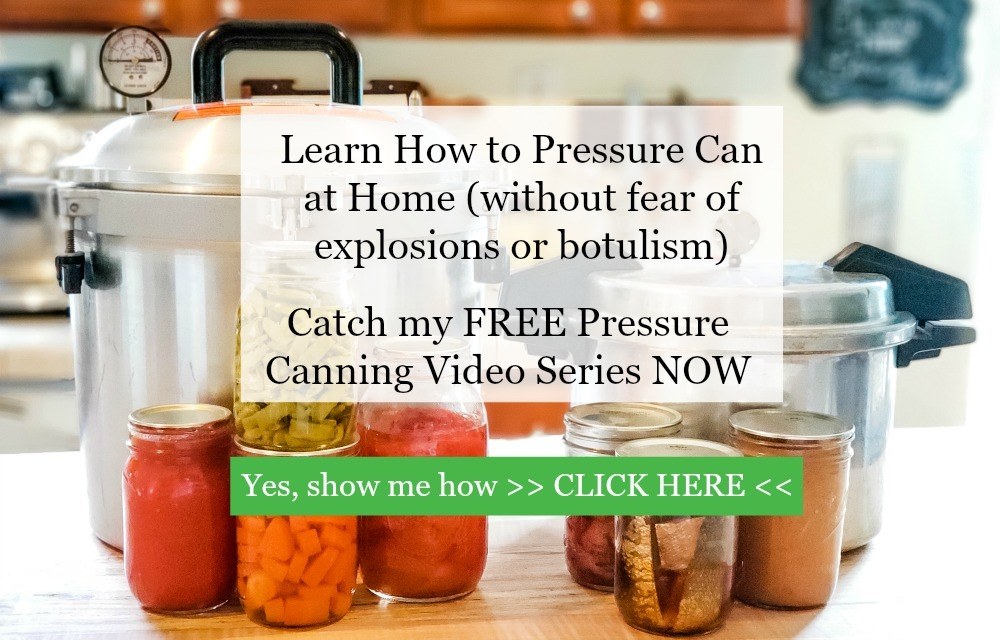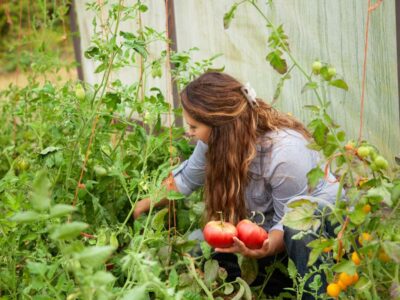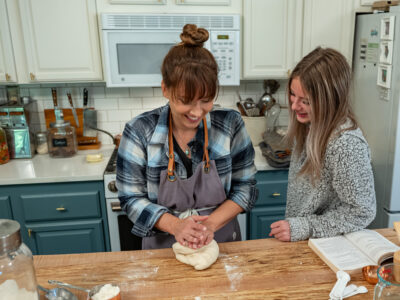Wondered about canning in electric pressure cookers? Are you interested in pressure canning but also worried that you will make a mistake that causes your canner to explode or your family to get sick? I have good news for you: pressure canning doesn’t have to be scary! In fact, it’s one of my favorite methods of food preservation.
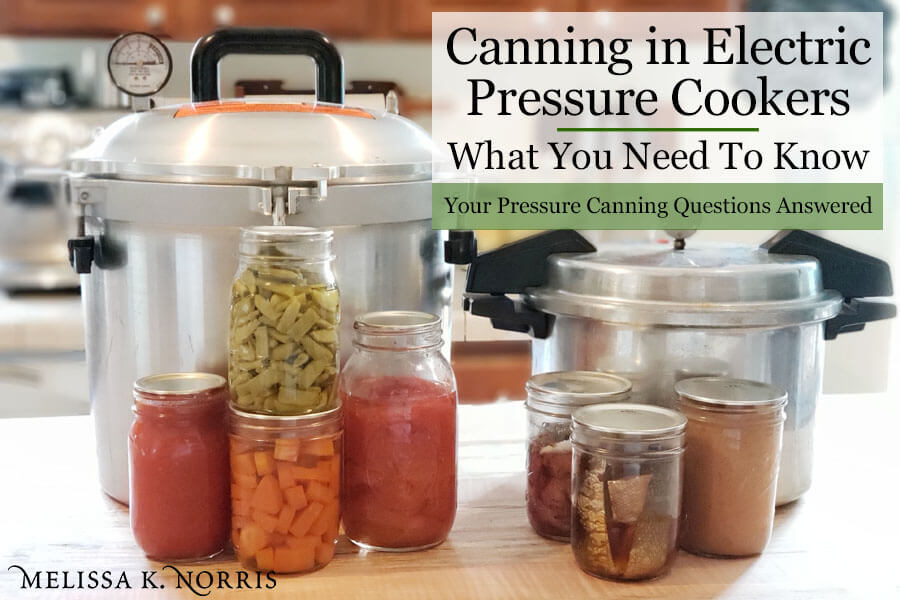
In today’s post, I answer a variety of common questions about pressure canning to help you feel confident in preserving your food in this way.
Listen in below to the full podcast, Episode #190 Pressure Canning: Your Questions Answered, of the Pioneering Today Podcast, where we don’t just inspire you, but give you the clear steps to create the homegrown garden, pantry, kitchen and life you want for your family and homestead.
Before we get started with our Q&A, there’s an awesome resource I don’t want you to miss. Right now, thousands of listeners and readers are working their way through my free pressure canning video series. I’m thrilled about this. Pressure canning gives you the ability to can vegetables, meats, soups, and broths, meaning they are shelf stable and simply need to be reheated before they are ready to serve. Pressure canning may seem intimidating, but in the e-course, I’ll teach you everything you need to know to pressure can safely and fill your shelves with nourishing, home-cooked, ready-to-eat meals. Click here to access this free video series right away. And now on to your questions about pressure canning!
Table of Contents[Hide][Show]
- Can I use an electric pressure cooker or electric canner to pressure can?
- Two reasons you shouldn’t use an electric pressure cooker for pressure canning
- Can you steam can in a pressure canner?
- How do you can smoked fish?
- What if the pressure falls below the amount needed for my recipe?
- Should my pressure canner have to be constantly adjusted during the cooking time?
- Is well water safe for canning? What should I do about mineral deposits in my canner?
- Why is my canner turning dark inside? Is it still safe to use?
- How much water should I add to my pressure canner?
- What does “double stacking” mean when pressure canning, and how can I do it safely?
- What type of pressure canner should I buy?
- How do I know if an older model of pressure canner is safe?
- How long will I have to wait between pressure canning multiple batches in the same day?
Can I use an electric pressure cooker or electric canner to pressure can?
No, you cannot use an electric pressure cooker to pressure can in. (Not to be confused with electric pressure canners. Here is more information on the pros & cons of electric pressure canners.)
Most people are familiar with the Instant Pot, and Ball also has an electric water bath canner, but you cannot use those to safely pressure can. People have asked me about using these for pressure canning, and the confusion is understandable. But just because a pressure cooker like the Instant Pot cooks under pressure, that doesn’t mean you can use it to can.
There are some models of electric pressure cookers that include pressure canning information in their operation manuals or were advertised with that capability.
However, when they went through third party testing, they failed. This research was conducted by the National Center for Home Food Preservation, and you can read their article for more information.
Two reasons you shouldn’t use an electric pressure cooker for pressure canning
Electric pressure cookers fail to can safely for two major reasons.
1.You can’t select the exact pounds of pressure. For example, if you live less than 1000 feet above sea level, your meats, vegetables, and combination recipes like soups require ten pounds of pressure. If you live at a higher elevation, then you must increase the pressure by five pounds and can at fifteen pounds of pressure. Safe pressure canning requires you to select the correct pounds of pressure for the recipe and your altitude. Unfortunately, most electric pressure cookers do not allow you to pick the pounds of pressure applied.
2. Pressure isn’t evenly held throughout the entire time. Secondly, even if a pressure cooker allows you to choose the pounds of pressure, it does not maintain that pressure throughout the processing time, meaning it cannot kill dangerous bacteria in the food you’re canning.
For these reasons, it is not considered safe or recommended to use an electric pressure cooker to pressure can, regardless of what the manual says. If you know anybody who thinks they can pressure can in an electric pressure cooker, please, share this post with them. Share it on your Facebook, your Instagram, wherever you hang out on social media so that we can get the word out. Because pressure canning is amazing and can totally be done in a safe manner. I would love it if every house was canning and putting up their own food in a safe way. So please help me get the word out so that people learn to can in a safe manner.
Can you steam can in a pressure canner?
Yes, however, it’s not really what I would call steam canning.
I’ve seen people put their jars into the pressure canner and place the lid on, but not tighten down the lid. Then, they’ll start their time once the steam starts escaping from the pressure canner. This sounds good in theory. However, I’ve never seen it deemed safe from a tested source.
What I have done instead is to use my pressure canner as a water bath canner. I demonstrate how to do this in my Home Canning With Confidence course. If you’re looking for more information and tutorials on canning, I highly recommend checking out that course.
But to do this, I simply fill the canner as I would a water bath canner until my jars are completely submerged, then use a cookie sheet as a lid.
How do you can smoked fish?
When canning smoked fish, you don’t actually smoke it the same as if you were just going to eat it after smoking. You only half-smoke it to where it’s not completely raw, but it’s also not hot to the touch, then you can it from there.
What if the pressure falls below the amount needed for my recipe?
Many people wonder what to do if their canner’s pressure falls below the recipe’s requirements during processing. For example, let’s say you are canning pints of green beans, which I show in detail in my free video series. At my altitude, I use ten pounds of pressure for twenty minutes. You do not start your time until your pressure canner is actually at the correct pounds of pressure. Once it hits ten pounds of pressure, you begin your timer. Your canner must stay at the correct pressure for the entire processing time to ensure that any botulism spores or other forms of bacteria are killed. So, if I was sixteen minutes into canning my green beans and the pressure dropped below ten pounds, then I have to start my timer all over again. The times in pressure canning recipes are very specific to the required temperature. Dangerous spores are only killed when they’ve been held at that temperature in pounds of pressure for the entire processing time. For that reason, if your pressure drops when you’re processing, you have to start over.
Should my pressure canner have to be constantly adjusted during the cooking time?
Though your pressure canner shouldn’t have to be constantly adjusted, it may need a few adjustments, especially when it’s just coming up to pressure.
Having to constantly adjust it could mean that you’re bringing it up to temperature too quickly, then needing to find the right temperature to maintain the pressure. If this is the case, try bringing it up to pressure a bit slower by using a lower temperature.
The other thing to consider is your stove. It could be that you have a faulty burner, as I’ve experienced this myself.
Is well water safe for canning? What should I do about mineral deposits in my canner?
This question first popped up in the Pioneering Today Academy, my membership site. That is one of the places you can find the Home Canning with Confidence course. One of our members was using her pressure canner for the first time, and she noticed some white deposits on the outside of the jars and on the inside of her canner. This is usually caused by hard water or various minerals when you’re using well water.
Because we are so rural, we are on our own well. I’m actually glad because I don’t have to worry about chlorine and other chemicals used in water treatment. We have our well water tested to make sure that it’s safe for us to drink, and it is definitely safe for canning. In fact, it’s all I’ve ever used for canning, both growing up and since I was married and started canning on my own. If your well water contains a lot of minerals, especially calcium, you may notice some deposits, like little white particles, after you have canned. As you’re pulling your jars out of the canner, deposits may be left behind either on the outside of the jars or even inside the pressure canner. If you see that, don’t be concerned. It’s normal and your jars of food are totally fine. However, you can avoid mineral deposits by adding half a cup of vinegar to the water that you put in the canner.
Why is my canner turning dark inside? Is it still safe to use?
When you first get your pressure canner, it’s a nice silver color. But when you operate it for the first time, unless you’re canning something like tomatoes, it will turn dark inside where the water was. You may think, “Oh my goodness, is this normal? What’s going on?” It’s totally normal, and just as I suggested to avoid mineral deposits, you can throw some vinegar in there and that will help. When you can tomato sauce for instance, the acid from the tomatoes does leak out a little bit during processing, and it will turn your pot silver again. But the very next time you use it for something that does not have tomatoes in it, it’s going to turn dark again. It’s a normal sign that you are using your pressure canner. Consider it a badge of honor!
How much water should I add to my pressure canner?
Generally speaking, you’re going to put about two inches of water in your canner. When you’re pressure canning, you don’t fill it all the way up like you do with a water bath canner. Of course, read the manual on your pressure canner. My older pressure canner actually specified one and a half quarts of water inside, which equals out to about the two inch line. My other twenty-one and a half quart All-American canner says to put in two inches of water. Ultimately, follow what your manual says, but it’s probably going to equal about two inches of water.
What does “double stacking” mean when pressure canning, and how can I do it safely?
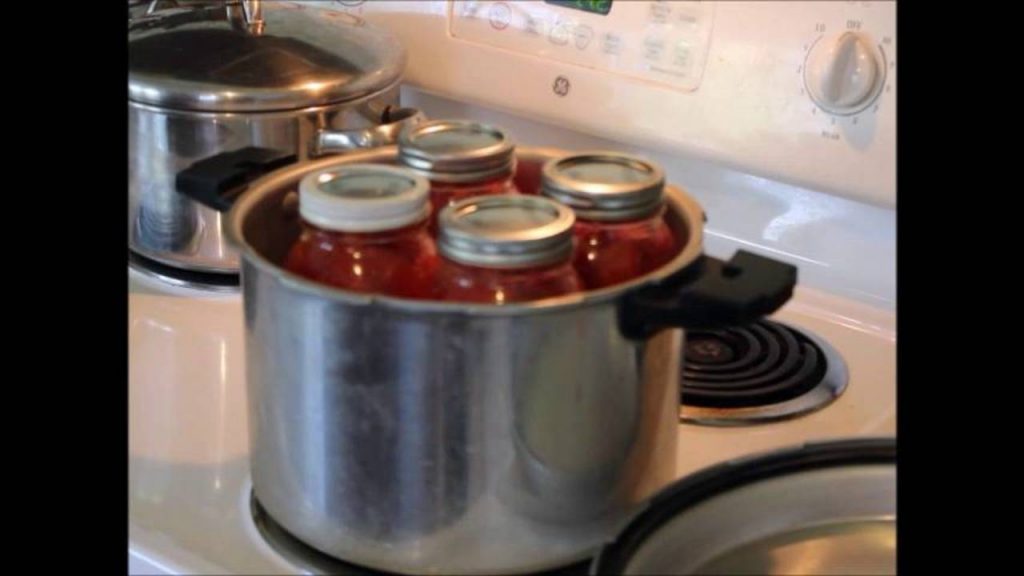
As my kids grew, I started canning more and needed to do more at a time. At that point, we invested in the twenty-one and a half-quart All-American canner.
Now, twenty-one and a half quarts doesn’t mean you can fit twenty-one-quart jars in it at a time. Instead, that’s how much liquid the pot could hold. I can process seven-quart jars, or I can double-stack and process nineteen pints at a time.
The only thing you need to remember when filling your pressure canner is how long the pressure canner needs to be running for your specific recipe. If you’re processing something with a long processing time (say 75 minutes), you’ll want to make sure you’re up to about three or four inches of water inside your pressure canner before you add your jars.
If your processing time is much shorter, you can get away with about two inches of water.
This holds true whether it’s one jar, a single layer, or double-stacked with jars.
Also, when double-stacking, you will need to use a second rack. I have a video on YouTube demonstrating the procedure I use when I’m double-stacking jars for pressure canning, so you can watch that to see double-stacking in action.
What type of pressure canner should I buy?
I’m often asked what size or type of pressure canner I recommend. I actually have an entire blog post with links and advice because the answer is not as simple as “this is the best one.” Your choice of pressure canner depends on the size of your family, your budget, and the type of stove you use. You can read my earlier post for a more in-depth answer, but I will talk a little bit about it here as well.
If you have a glass stove top, then there are only a couple of models of pressure canner that will work for you due to their weight and shape. Definitely look at what your stove manual says. I did find a couple that specifically said they were safe for glass top stoves, like this Presto Pressure canner . I don’t have a glass stove top and I have not canned on one, but I do have several people in the Pioneer Today Academy and within the Home Canning with Confidence e-course who have glass top stoves. They make a point to be very careful when they’re lifting the canner on and off the stove and they can successfully on their glass top stoves.
If you have an induction stove, you can’t use a pressure canner on it. Instead, you can purchase a propane camp stove that’s on legs and create an outdoor kitchen. I do this when it gets really hot and do a lot of my canning out there. I also know people use a propane burner on their gas grill and pressure can that way. So, if you have an induction stove or you have a glass top that you are not comfortable using to pressure can, there are options besides putting an entire new stove in your kitchen. This is the outdoor stove I use for canning.
With a gas or electric stove, you can use any type of pressure canner. If you think you want to double stack and you have the funds, go for the bigger pressure canner. You don’t have to double stack all the time, but it gives you the option for those times when you need to process higher volume.
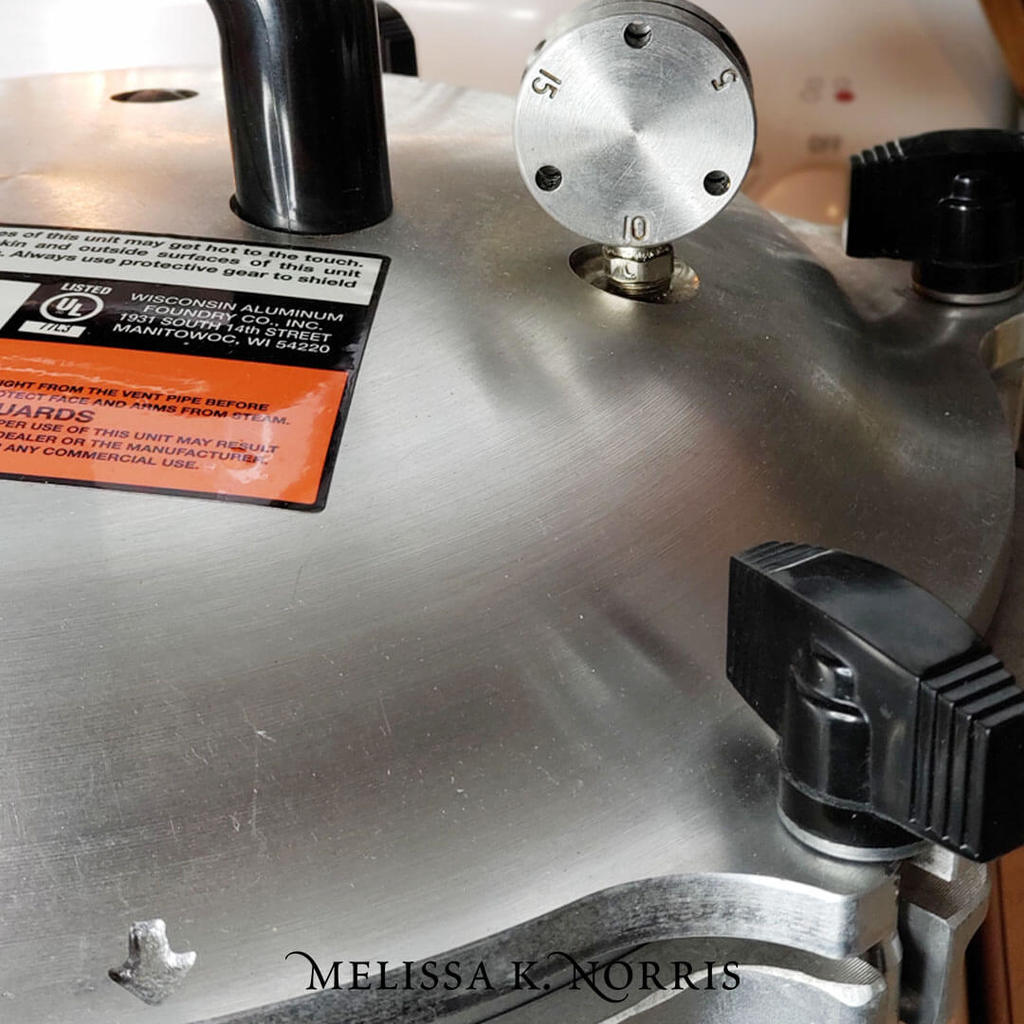
We always have to consider our budget as well. There are definitely some models of pressure canner that aren’t expensive, but they get the job done just fine. I cover exact models in my previous blog post, which is linked above. All the same information is available as part of my pressure canning series as well.
How do I know if an older model of pressure canner is safe?
It’s very normal to be nervous about using a pressure canner, especially an older model. There are ways to know if the pressure canner you purchase used or have at the back of your cupboard is safe. If you have a pressure canner that only has the dial gauge that shows pounds of pressure and doesn’t have the weighted gauge that you put on the little vent pipe, then you need to get the dial tested. Most county extension offices will do that for free, and you should have the dial gauge tested once a year to ensure that it displays the correct pounds of pressure. If you have the weighted gauge, you can always trust it and ignore the dial because the weighted gauge is never going to read inaccurate. That’s the beauty of a weighted gauge.
If you come across a super old gasket-type pressure canner, like one that was your grandma’s from forty or fifty years ago, make sure that you replace the gaskets. Over time, the rubber will shrink up and get brittle and then it actually can’t seal. Instead, it allows some of the steam and the heat to release so the canner can’t build up to the correct pressure. Always purchase new gaskets if you’re buying a used canner or it’s been a while since they were replaced. They’re fairly inexpensive, ten dollars or less, meaning you can also keep a backup one on hand just in case.
If a pressure canner is really old, check the bottom for a stamp on that says UL. Oftentimes it will be in parentheses. If it doesn’t have that, it’s probably too old to safely use as a pressure canner. This advice comes from the National Center for Home Food Preservation, which tests and documents safe food preservation methods here in the United States and is considered one of the primary resources for safety and information regarding canning at home.
How long will I have to wait between pressure canning multiple batches in the same day?
If you are processing multiple batches of canning a day with your pressure canner, you may wonder how long you need to wait between canning sessions. At the end of your processing time, you should turn off the heat under your pressure canner and leave it alone. Don’t ever try to remove the canner before the pressure has released naturally by cooling off and returning to room temperature. Pressure cookers may instruct you to use cold water or a valve to manually release pressure, but you don’t ever do that with your pressure canner. Instead, just turn off the heat and allow the pressure to release naturally.
Once the pressure is released, you can carefully take off the lid. In my pressure canning course, I demonstrate some different tests to determine when it’s safe to remove the lid. Because if you try to remove the lid when it’s under pressure, it could burn you or, depending on how much pressure remains, push the lid up with a lot of force and hot steam. Most models have locks on them now so that you can’t open them while they’re under pressure, but I also teach you some other safeguards make sure the pressure is truly reduced all the way before the lid comes off. The steps are simple once you know them.
Once the pressure reduces and you remove the lid, it’s important to wait ten minutes with the lid off before you remove the jars to a folded towel on the counter to finish the cooling process. There are two reasons for this ten minute wait. First is siphoning, which has to do with the headspace in your jars. Headspace is simply the space between the top of the liquid to the top of the jar, and every recipe calls for its own amount of headspace. Never adjust the headspace from what the recipe says, it’s very important for the success of the canning process. Regardless, canning does lead to a loss of liquid, called siphoning, and leaving your jars in the canner for ten minutes after the lid is removed helps reduce the amount of siphoning.
Secondly, we leave the jars in the canner because we want to avoid any type of temperature shock to our glass, which could cause the jars to crack or break. Give your jars an extra ten minutes before going from the extremely high temperature in the canner to room temperature. This is also why you always put your hot jars on a folded towel. Avoid broken jars by never setting freshly canned items directly on a cold countertop.
Your wait for the canner to reduce its pressure naturally, including those ten minutes with the lid off, should take about forty-five minutes. Depending on the size of your pressure canner, the temperature in your home, and other factors, it may take as little as thirty minutes. But generally, you should give yourself about an hour from the time that you have turned off the burner for a processing time until you can remove the jars and start another batch. You could definitely do multiple runs with your pressure canner within the same day, but you have to plan for that barrier period of about an hour for your canner to release its pressure before you put the next run in.
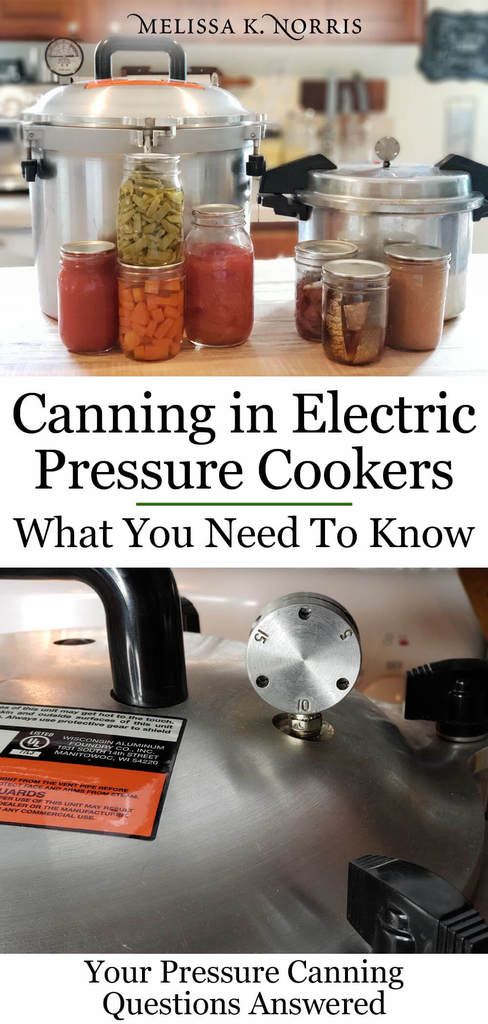
That covers the pressure canner questions that I’ve heard lately. If you want more information about confidently pressure canning at home, be sure to check out my free video training! And check back soon to register for the organic gardening workshop that’s coming your way this October. Until next week, happy canning and happy gardening!

